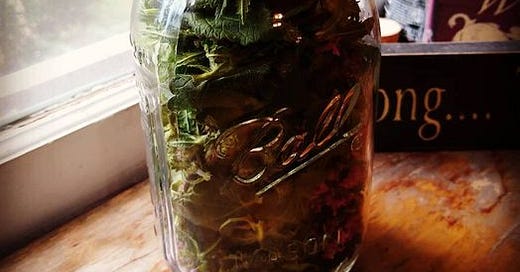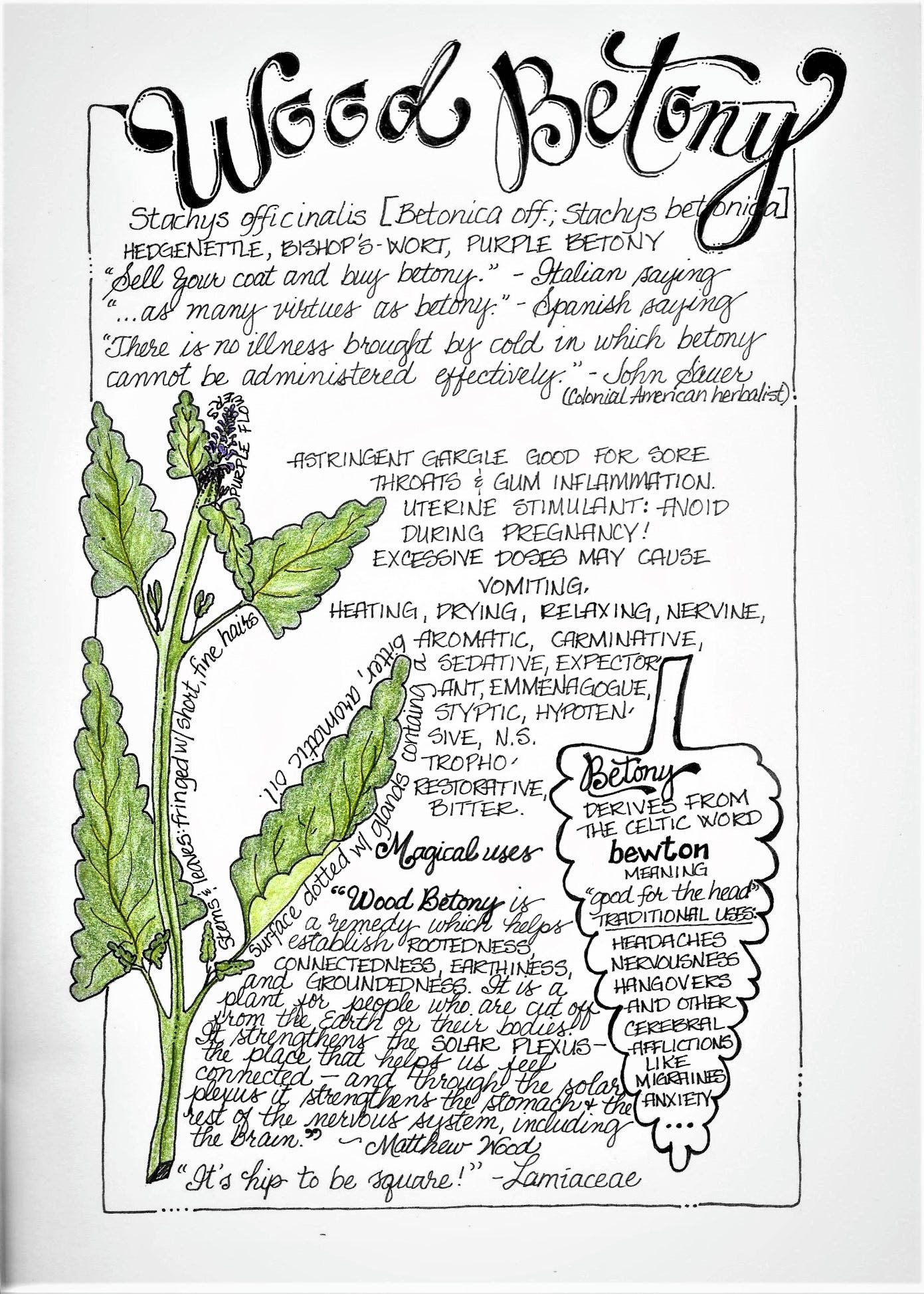Fresh Wood Betony (Stachys officinalis, Betonica off., Stachys betonica --- I include all these names because you might find it listed under any one of these depending upon the age of your source material.)
Quite simply, Wood Betony makes me smile. I have a medley of memories associated with this relatively little-known plant, and all of them entertain and delight me. At one time, this plant was considered practically a panacea. Italians had an adage ‘Sell your coat and buy Betony,’ while the Spaniards would extend the superlative compliment: ‘He has as many virtues as Betony.’ Historical physicians of the Middle Ages, who were by definition herbalists, used Wood Betony for dozens of ailments and diseases.
This plant’s name are said to come from Celtic origins of bew (head) and ton (good), meaning it is good for head afflictions of all sorts. Although the list of indications in ancient texts is seemingly endless, today we would use this herb for all sorts of headaches, including some migraines, for anxiety, heart palpitations, neuralgia, nervous system disorders, and insomnia. These are the primary uses I have experience with, but I admit to an affection for Lemon Balm (Melissa officinalis) for many of these same conditions and these two Mint Family plants go well together.
Ancient herbalists would have also used Betony in cases of dyspepsia, rheumatism, scrofula, impurities of the blood, colds and coughs, wheezing, shortness of breath, consumption [tuberculosis], putrid agues [fevers], as a vermifuge [destroys parasitic worms], to stop a nosebleed, to heal sores, ulcers, or boils, convulsions, gout, and…well, you get the idea. That’s basically what a panacea is, a cure-all.
Betony’s talents were not limited to the mundane or physical. It was believed to protect one from evil and on this account, it was often planted in churchyards and worn as an amulet or charm ‘sanctifying’ those who wore it. Specifically, it protected wearers from fearful visions and effectively drove away devils and despair. There are many superstitions and tales about this health-supporting and magical plant. One of my favorites involves the belief that serpents would fight and kill each other and/or themselves if placed within a ring composed of Wood Betony. I haven’t tried to verify this, since I have some personal superstitions about handling serpents.
More than a thousand years ago Wood Betony would have been consumed in a variety of ways in addition to drinking all parts of the plant as tea. It was smoked either alone like tobacco or combined with Eyebright and Coltsfoot to relieve a headache. Powdering the herb and using a pinch as snuff brought on violent sneezing, which definitely could clear one’s head of congestion. M. Grieve (A MODERN HERBAL) says that the fresh leaves have a mildly intoxicating effect. Naturally, I tried them both dried and fresh and found them to be relaxing when consumed in moderation but a little nauseating when brewed too strong or long. I brewed a big pot of fresh leaves and steeped it for 20 or 30 minutes before sipping several cups while relaxing in an herbal bath (Lavender if I remember correctly.) and nearly fell asleep in the tub. When I finally stood up, I was slightly woozy, but thankfully I was headed to bed. After that, I learned to use Betony with a lighter hand in the teapot and with a bit more respect.
Although the roots are not much used today, all the above ground parts are excellent in a variety of preparation including syrups, elixirs, teas, electuaries (powdered herbs in honey to form a paste), oils, salves, plasters, and conserves. Jeanne Rose in her classic HERBS & THINGS states that the roots taste horrible and induce vomiting or as Culpeper says in his famous herbal: ‘The root of Betony is displeasing both to the taste and the stomach, whereas the leaves and the flowers, by their sweet and spicy taste, are comfortable both to meat and medicine.” Both Rose and Culpeper wrote that Betony is good for all diseases of the head: for watery eyes, aching ears, and inveterate headaches.
One of the common names for this plant is Woundwort, possibly due to the fact that the leaves were sometimes used as a dressing for wounds in place of linen bandages. Betony was so popular and universally used for so long that one wonders why it rarely shows up today in apothecaries and formulas. I even had a bit of trouble finding seeds and plants when I started my own plants. It grows so well and is pest- and disease-free, offering many benefits to the garden and grower. It should be much more widely appreciated.
Hildegard von Bingen, 12th century herbalist, mystic, healer, and polymath wrote in her PHYSICA:
"Wood betony is warm and dry, and it contains good powers. It is suitable for internal consumption and external application. It works against the black bile and helps to restore a balanced humor in the body."
Hildegard followed the medieval medical theory of the four humors (blood, phlegm, yellow bile, and black bile). Wood betony was particularly noted for its ability to combat "black bile," which was associated with melancholy, sadness, and imbalances of the digestive and nervous systems. It was believed to have a warming effect, which could counteract the "coldness" attributed to certain illnesses or emotional states. She also used Betony for mental clarity and spiritual protection.
In Greek and Roman times, Wood Betony was one of the most popular herbs so its absence in modern times leaves me with lots of questions. Contemporary herbalist, Matthew Wood, is one of the few who spotlights this delightful plant in THE BOOK OF HERBAL WISDOM: Using Plants As Medicines. As in all of his work and teachings, Wood never covers a plant superficially or makes simplistic references to this-herb-for-that-symptom. I will try to give a synopsis compose of quotes of his section of Wood Betony and the solar plexus, but I highly encourage you to refer to this excellent herbal resource for more details.
According to Matthew Wood, “If we can understand the nature of the solar plexus, we will be able to take in why this is such an important and powerful remedy, innocuous though it may seem. The solar plexus is one of the most significant nerve centers in the body. It is the switchboard for digestive functioning and gut-level instincts and reactions. As such, it is a terribly important center, and any medicine which acts upon it is liable to be constantly needed. So closely is Wood Betony associated with the solar plexus, that it is impossible to separate the two. It serves as an archetypal medicine plant illustrating this nerve center…The solar plexus is ‘the brain of the stomach,’ but at the same time it is the instinctive brain or ‘gut-level instinct’ center…Because the solar plexus is such a large nerve center, debility and decline often affect the nervous system as a whole when it is affected. Through lack of stimulation and coordination of function, the nervous system becomes susceptible to atrophy and decline. There is also undernourishment of the tissues from lack of digestion. Weakness gives rise to an inability to deal with stress and this creates nervous and muscular tension. These interact to create high blood pressure and arterial tension---symptoms associated with Wood Betony today…Diminished cerebral blood flow and nerve activity are the likely result of debility in the solar plexus. There is also a problem on the psychological level. When the solar plexus is functioning strongly, a person’s inner life is enriched by intuition, instinct, and zest for life. This brings into play a more complete array of emotions and thoughts, which is healthy for the brain and thought-life.”
There is so much more that can be said on the topic of Wood Betony and the solar plexus as a center of health and vitality in our lives. If the tip of this herbal “iceberg” intrigues you, I urge you to learn more in Matthew Wood’s BOOK OF HERBAL WISDOM. For myself, I am enjoying pots of Wood Betony tea to nourish and strengthen my gut-brain/solar plexus, digestion, and nervous system before the holidays. Join me if you will!
Specimen of Wood Betony from my herbarium. Relax with a cup of Wood Betony tea and study the details of this elegant Mint Family plant carefully.
Magically, Betony is an herb of protection. It was added to Midsummer bonfires and jumping through the smoke was said to purify the body of ills and evil. It has traditionally been planted around the home, or leaves were scattered around doors and windows for protection. The leaves can be placed beneath the pillow to protect the one sleeping on it from nightmares. Elementally, Betony is a fire plant under the rulership of Jupiter. Carrying some Betony on your person is said to improve confidence and communication with others, prevent intoxication (Avoiding intoxicants helps, too!), strengthens the body, and protects again “elf-sickness.”









A wonderful essay on Betony! I have never grown, studied or used this herb but in my new herb garden I am planning, I am adding it to my list.
This is such an interesting post Leenie! Great how you have brought in how others have understood Betony over the years, in addition to your experimenting. Also very interested to read Matthew Wood's thoughts on the use of Betony to stimulate and rejuvenate the Solar Plexus. Very interesting! I recently have added some exercises to tone this area of the body by simply drawing one's mid-section in as if you were pulling it away from an attack. Quick drawing in and then slowly exhaling. From Wood's description of where the solar plexus lies and our need to give it our attention, I feel I am doing a good thing, which might be followed with a cup of mildly brewed Betony tea. Thanks so much for how you share your herbal knowledge with us!